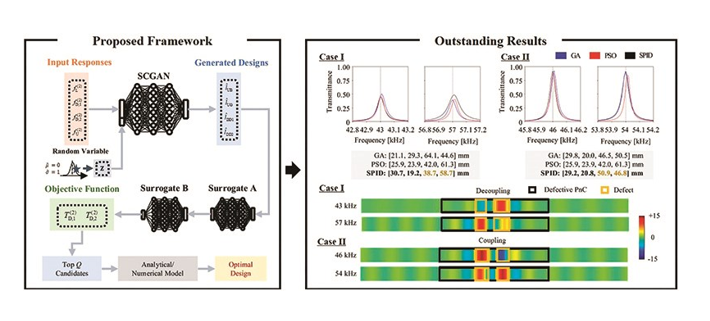2025 Inverse Design of Defective Phononic Crystals Using Surrogate-assisted Conditional Generative Adversarial Network
본문
- Journal
- Journal of Computational Design and Engineering
- Date
- 2025-07
- Citation Index
- SCIE (IF: 6.1, Rank: 6.6%)
- Vol./ Page
- Vol. 12, No. 7, pp. 129-147
- Year
- 2025
- Link
- https://doi.org/10.1093/jcde/qwaf060 39회 연결

Abstract
Deep learning (DL) has significantly advanced the analysis and design of phononic crystals (PnCs), particularly in perfectly periodic structures. However, the investigation of defective PnCs – those incorporating disordered structures to disrupt periodicity – remains limited. Two major challenges have been identified in prior studies: the need for a more capable inverse design framework to manage the increased physical complexity (e.g. coupling and decoupling phenomena) associated with multiple defects, and the absence of comprehensive comparisons with conventional optimization methods. To address these limitations, a novel framework termed surrogate-assisted CGAN (SCGAN)-powered inverse design (SPID) is proposed. SCGAN enhances generalization beyond traditional conditional generative adversarial networks (CGANs) by introducing ‘surrogate-assisted loss’, ‘Wasserstein distance’, and ‘gradient penalty’, thereby stabilizing convergence and enforcing design constraints. The SPID framework effectively handles double-defect configurations by capturing defect interactions, enabling maximization of transmittance at target frequencies and robust performance under complex scenarios. The framework’s performance is validated through test datasets and practical design problems, with comparisons drawn against genetic algorithms and particle swarm optimization. Once trained, the SPID framework automates the design-to-evaluation process, generating physically feasible defective PnC designs for narrow bandpass filtering within seconds. Potential applications include the development of high-sensitivity ultrasonic sensors and actuators for structural health monitoring in infrastructures.
